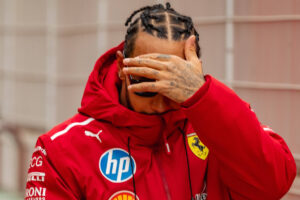Breaking: Lewis Hamilton disqualification proves Mercedes got lu…read more

Lewis Hamilton’s Disqualification Highlights Mercedes’ Stroke of Luck at Bahrain GP
Lewis Hamilton’s much-anticipated debut season with Ferrari has been far from a dream start. With four races already completed in the 2025 Formula 1 season, the seven-time world champion has only managed to gather 25 points. He currently sits seventh in the drivers’ standings—behind the young Italian driver who replaced him at Mercedes.
One of the most dramatic moments of Hamilton’s season so far came during the Chinese Grand Prix weekend. He claimed a sensational sprint race victory, but just two days later, he faced heartbreak with a disqualification from the main Sunday race. However, a similar drama nearly unfolded for his former team at the Bahrain Grand Prix.
Mercedes, now racing without Hamilton for the first time in over a decade, has shown consistent form with George Russell and rookie Kimi Antonelli regularly scoring points. But at the Bahrain GP, Russell narrowly avoided a situation that could have mirrored Hamilton’s 2021 disqualification.
Back in the 2021 Brazilian Grand Prix, Hamilton was disqualified from qualifying for the sprint due to a technical infringement with the rear wing of his Mercedes. The issue was with the Drag Reduction System (DRS)—specifically, the gap between elements of the wing when the DRS was activated. The FIA found that the wing exceeded the allowed 85mm maximum gap at the outer section, despite passing in the inner section. After repeated tests, the stewards confirmed the breach and Hamilton was sent to the back of the grid.
Fast forward to Bahrain 2025, and while the circumstances were different, Russell too found himself in hot water post-race. After finishing second, he was placed under investigation for a potential DRS rules violation. But unlike Hamilton’s equipment-related infraction in 2021, Russell’s issue stemmed from how the DRS was activated.
According to the FIA, Russell was dealing with electronic problems, including a brake-by-wire fault. While trying to contact the team via radio, he pressed an auxiliary button in the cockpit, which also functions as a manual DRS activation. This led to an unintended activation of the DRS outside of the permitted zone, between Turns 10 and 11. The system remained open for 37 meters on a straight that spans around 700 meters.
Despite technically breaching the rules, the stewards decided against penalizing Russell. Telemetry showed that while he gained 0.02 seconds from the accidental DRS use, he lost 0.28 seconds at the following corner, effectively neutralizing any advantage. The FIA determined that no sporting gain had been made, and thus, no penalty was imposed.
The contrasting outcomes of these two incidents raise questions about consistency in stewarding decisions. Had Russell received even a minor penalty—like a five-second time addition—he would have lost his podium finish. In light of this, it’s fair to say that Mercedes may have had a lucky escape in Bahrain, avoiding what could have been a costly and controversial penalty.





